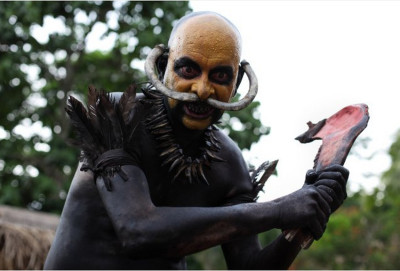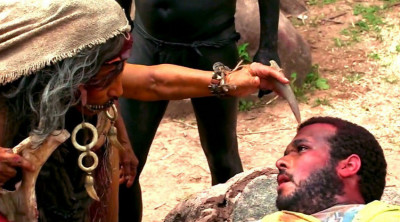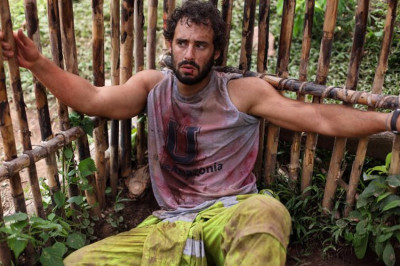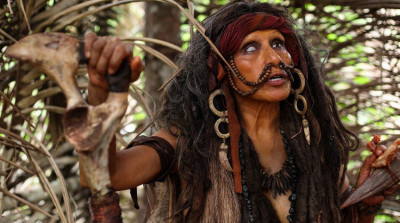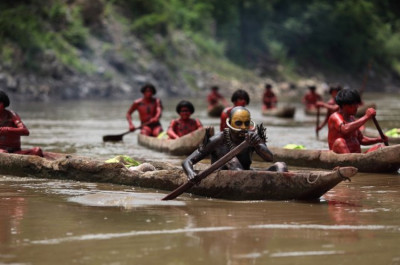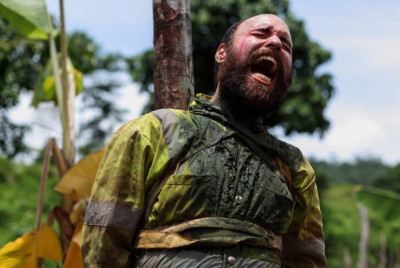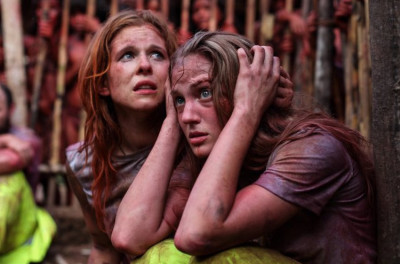Eli Roth returns to the director’s chair for the first time since “Hostel” and it’s not a moment too soon. As producer of the acclaimed “Aftershock”, Roth shifted focus and production to the lush regions of Chile and the Amazon. The result in the Nicolas Lopez helmed film proved to be not only visually saturated and sensational, but had a vibe that was fresh, energized and exciting. Roth now returns to Chile and Peru with “The Green Inferno” capturing that vibrancy and energy, along with some of the most beauteous images and use of color saturation on screen today, for what can only be described as the tastiest of cinematic treats. As Roth himself joked at the recent press day, “‘The Green Inferno’ is my mic drop.”
As are most college freshman, Justine is easily impressed by the collegiate atmosphere, the potential for activism and attention, and the hot guys. Spying the handsome Alejandro from afar at a protest rally, she wants to meet him and soon finds her way into his group of activists thanks to a kind invite from the soft spoken and naive Jonah. It doesn’t take long before Justine is swept up in Alejandro’s plans to stop the deforestation of the rain forest and heads off for a weekend excursion to a remote area of Peru with a group of other similar dewy-eyed hopefuls.
But as we know, the best laid plans often go awry and this protest is no difference. After being attacked at gunpoint by the military assigned to protect the corporate employees developing the region, their only salvation are their cell phones and the wonder that is the internet and Twitter. Saved from certain death, the group is herded together and forced to leave the region. And as we come to learn, there’s more to Alejandro and his scheme than meets the eye.
Needless to say, things don’t go as planned on their flight to freedom and back to the States when the small plane crashes in the rain forest and the survivors are taken captive by a tribe of cannibals. As comes as no surprise, when you put cannibals and meaty foreigners together, there is plenty of food for comedic and horrific fodder, which is exactly what unfolds in extremely graphic and delicious fashion. So, who survives and who becomes dinner and dessert?
Calling on some of his best actors whom we last saw in “Aftershock”, and adding a few other faces both new and old, the cast on the whole, is well rounded, multi-cultural and resonant, starting with Ariel Levy who gets to be a douche as Alejandro. He is charismatic commanding which seals the deal when it comes to enlisting the newbies into Alejandro’s cause. Watching Lorenza Izzo is a joy as you see her growth as an actress just from “Aftershock” to here as Justine in “The Green Inferno”. (I can’t wait to see what she does in “Knock Knock” which releases on the heels of “The Green Inferno”.) Kirby Bliss Blanton provides some of the more stereotypical prissy dumb blonde touches as Amy while Nicolas Martinez delivers perhaps the most emotionally textured performance as Daniel. Aaron Burns proves to be an absolute sweetheart and teddy bear of a guy as Jonah. And then there’s “Spy Kids” Daryl Sabara, now all grown up and adding his own patented brand of goofiness to pot-loving Lars. (And here’s a hint of things to come: What happens when you shove a bag of pot into a body being cooked by cannibals? Think about it.)
But the real casting coups are the actual members of the Peruvian tribe found by Roth while location scouting. The last first-world filmmaker to even dabble near this particular region of the Amazon was Werner Herzog and that was decades ago with “Aguirre, The Wrath of God”, and even he didn’t go as deeply into the remote regions of the Huallaga River as Roth and company. Although the children in the tribe do attend school up the river and are familiar with the modern world to a degree, the Callanayacu tribe and village itself has no electricity, no running water, no modern conveniences. Elders aren’t even aware of such things. Their only contact with outsiders is an occasional supply boat that supplements their farming community. (In case you missed it – they are not cannibals.) Yet somehow Roth managed to convince them to participate in the film, adding untold levels of authenticity and interest overall. Tribal members even aided in making props and set dressing, as well as all appearing as extras in the film. Particularly effective are the children, several of whom, according to Roth, even had some suggestions for filming certain scenes! They are beyond a delight to watch. However, the mesmerizing standout is professional actress Antonioeta Pari as the village elder. (Yes, a female village elder ruler!)
Written and directed by Eli Roth and co-written by Guillermo Amoedo and an uncredited Nicolas Lopez, the story structure is well done and fully encompassing with commentary on various social and geo-political issues. Having said that, they are all thinly veiled and I for one saw the twists and turns coming from a mile away. For Roth, however, one of the primary themes of “The Green Inferno” is social media. “[Y]ou see the kids in “The Green Inferno” and it’s not that they care about saving the rainforest, they care about being recognized for caring. It’s not when they chain themselves to the trees and do the protest. It’s when they stop the protest and they’re crying, they’re upset, so they’re going “What the hell did we get into?” but when CNN retweeted them, then they’re happy, then that’s the party.” Roth puts the mirror up to each of us and society as a whole. Thoughtful is Roth’s incorporation of the tribal lifestyle into the story. He never vilifies or condemns their way of life. If anything, the protestors are the intruders disrupting a culture. Speaks loudly as to many of the event occurring around the world today.
Visually stunning and, of course, Roth makes the most of his saturated red and green and yellow palette, both from a visual and metaphoric aspect, as cinematographer Antonio Quercia dazzles yet again. Making a conscious decision for the use of these three primary colors, key to Roth is that “no movies that look that way. I wanted to have a movie that can redefine what the look of a film like this is.” Every frame is rich, lush, striking, distinctive and adding a metaphoric dichotomy of beauty to the “horror” of acts unfolding. Notable is that Roth gives full credit to Quercia stating, “This photography is all him.” A unique touch is that the horror within “The Green Inferno” unfolds in daylight; this is not a movie with things that go bump in the night.
Manuel Riveiro’s classical scoring is beauteous and mirrors the lush richness of the Amazon jungle. Adding a wonderful layer to the overall construct of the film is the introduction of more tribal beats and startling individual tracks adding to the indelible score.
And stay through the credits. Some tongue-in-cheek fun just with the credits themselves.
“The Green Inferno” – too delicious for words. You’ve got to taste it for yourself.
Directed by Eli Roth
Written by Eli Roth, Guillermo Amoedo and Nicolas Lopez (uncredited)
Cast: Lorenza Izzo, Ariel Levy, Nicolas Martinez, Daryl Sabara, Aaron Burns, Kirby Bliss Blanton, Antonioeta Pari

